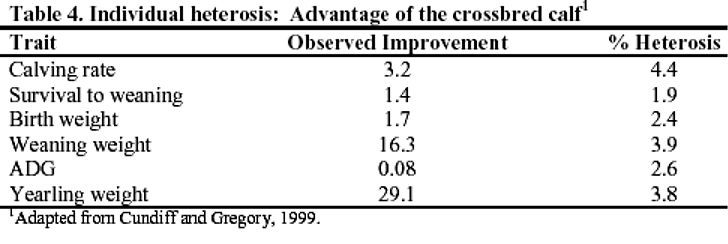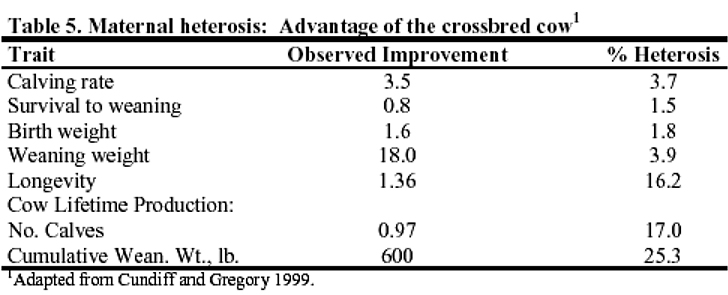Through the practice of crossbreeding, heterosis (or hybrid vigor) and breed complementarity are achieved within the herd. Heterosis can be defined as the superiority in performance of the crossbred animal compared to the average of its straight-bred parents. When valuing heterosis, you essentially gain a dual advantage: individual heterosis and maternal heterosis.
Individual heterosis results in an increase of calf survival to weaning, along with increased growth. Table 4 shows the increase in performance that can be achieved through individual heterosis. Through crossbreeding, calves have been seen to have a 3.9 percent increase in weaning weight and a 2.6 percent increase in average daily gain, all which translates to increased profits.

Similar to the definition of heterosis above, maternal heterosis is the advantage of a crossbred mother over the average of other purebred mothers. It refers to the combined improvement in traits from the dam that causes an increase in the performance of her and her progeny. Improved fertility, increased calf survivability, greater cow longevity, and more pounds of calf produced are examples of maternal heterosis.
As seen in Table 5, a crossbred cow has been shown to have a 16.2 percent increase in longevity and has proven to stay in the herd longer than a straight-bred cow. This table also reflects the increase in number of calves through a cow’s lifetime as we all as additional pounds of cumulative weaning weight and more profit for the producer. The effects of heterosis are greatest for lifetime production with a 30 percent improvement, longevity or herd-life with a 15 percent increase, and annual income improvement from heterosis at 23 percent.

The crossbred female is really where crossbreeding pays off. Traits that are most influenced by heterosis are those traits with low heritability, such as fertility traits. Traits that are most affected by heterosis can be seen below in the table below.
| Traits | Heritability | Heterosis |
| Fertility, mothering ability, calf survival | Low | High |
| Birth and weaning weaning weights, milking ability, and feedlot gain | Medium | Medium |
| Mature weight, carcass qualities | High | Low |
Utilizing crossbreeding systems also allows for the opportunity to capitalize on breed complementarity. This is the assessment of strengths and weaknesses of each breed type and applying those that complement each other. Breed complementarity is one of the best ways to describe the benefits of Balancer® cattle. Balancer animals are 25 to 75 percent Gelbvieh with the balance of Angus or Red Angus. They combine the Gelbvieh growth, muscle, leanness, fertility, longevity and low yield grading ability with the carcass qualities of Angus to make an animal that meets today’s modern industry demands.

Balancer hybrids offer a simple and powerful way to maintain hybrid vigor and the proper combination of British and Continental genetics in your cowherd in a straightforward and easy crossbreeding system.
Gelbvieh are also an ideal fit for a crossbreeding program because of their superior maternal characteristics such as longevity and fertility. Gelbvieh females are known for reaching puberty at an earlier age and remaining in the herd longer. With these attributes, combined with performance gained through maternal heterosis, Gelbvieh-influenced cattle make the ideal female for any herd. So, why not reap the benefits of the heterosis advantage?
Source: American Gelbvieh Association











